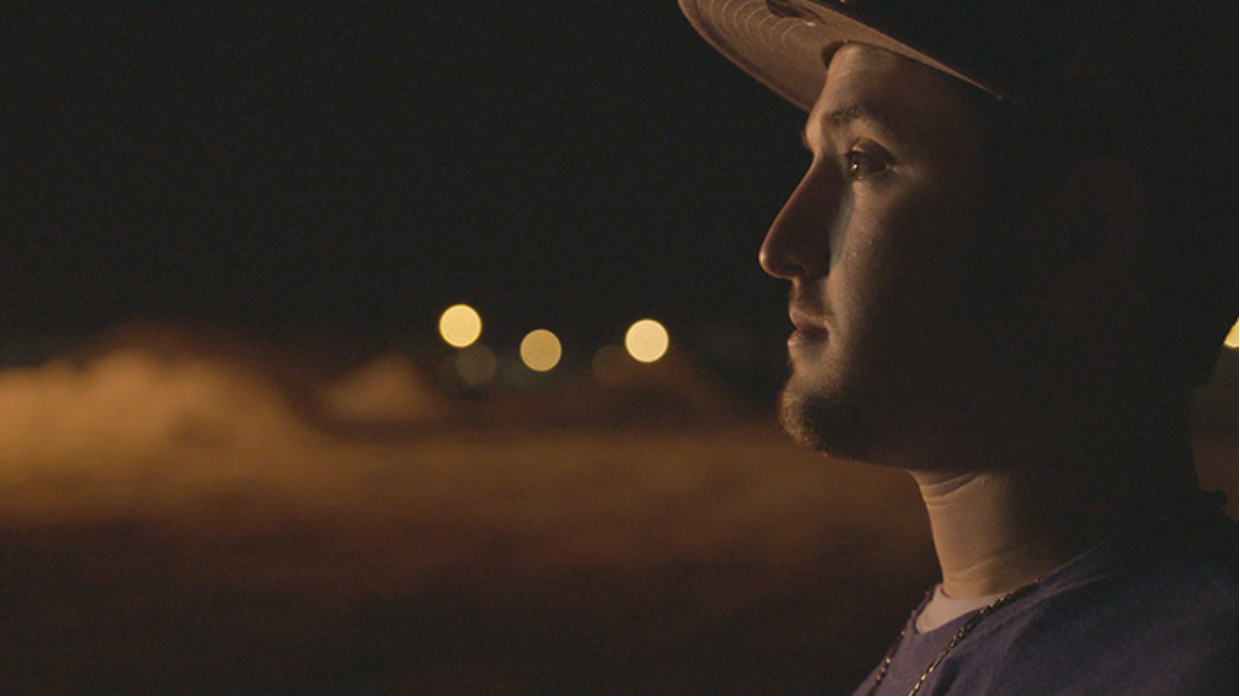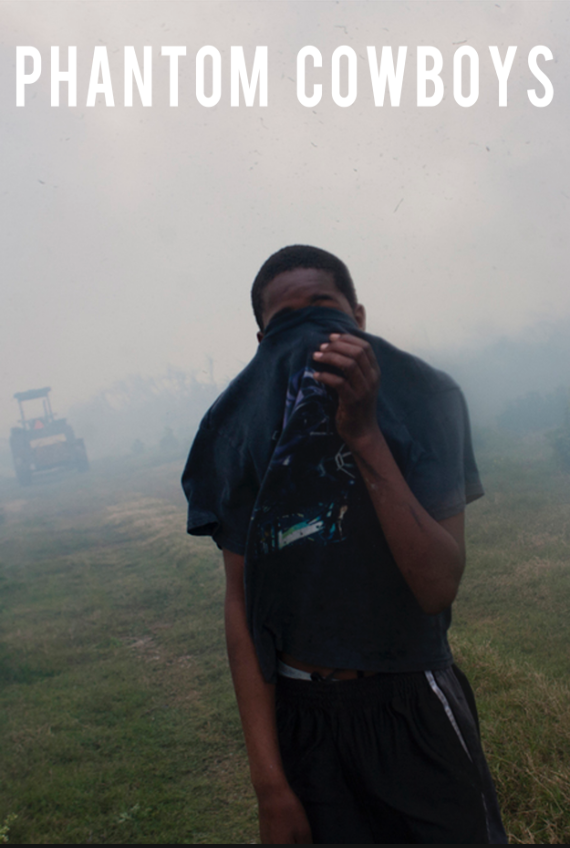|
Film by Daniel Patrick Carbone premiered at Tribeca; Sheffield International Film Festival up next
The young men profiled in Phantom Cowboys are not the kind who generally attract much attention in popular culture -- unexceptional kids of limited means who live in obscure corners of the country. Have-nots in a nation much preoccupied with the haves.
Larry Young hails from tiny Pahokee, Florida, a place surrounded by sugar cane fields. Ty Carpenter's home is Parkersburg, West Virginia, a town whose heyday came with oil and gas production a century ago. Nick Reyes lives in the small mining town of Trona, California known in part for a high school football team that plays on a dirt patch. Grass won't grow on the saline-saturated ground. Director Daniel Patrick Carbone brought cameras to these locations not with a pitying eye, or a condescending desire to "ennoble" his subjects, but to get a sense of the inner lives of young men growing up on the edges of American life -- edges at least under the boundaries drawn by Hollywood and mass media. "It was kind of an experiment to choose ordinary men in three different parts of the country and then let it unfold inorganically," Carbone told Nonfictionfilm.com. "We started shooting with these guys when they were as young as 13 so it's really hard to know -- it's impossible to know -- where that's going to lead." It was kind of an experiment to choose ordinary men in three different parts of the country and then let it unfold inorganically.
Carbone spent time with his trio of characters at separate moments of their lives -- first as adolescents with dreams and uncertain futures, and later as adults with an accumulated range of experiences circumscribing their lives. In the film he seamlessly shifts between his subjects at those different stages in their development.
His first step in making Phantom Cowboys was to identify communities where he wanted to film. "We found the places one by one based on a set of parameters we had in mind," Carbone explained. "We knew we wanted to explore very small, low population towns and also specifically towns that were former boomtowns -- towns that are built up around a single industry or a factory or a mine where generations of men traditionally would leave school and go into the same factory following in the footsteps of their fathers and their grandfathers." Pahokee is sustained in part by sugar cane cultivation. Low-income residents hunt for rabbits that flee the fields when the cane stalks are burned before harvest. "We had seen the rabbit hunting in Pahokee and we knew that was one [place] we wanted to film. And then Trona came once we heard about the [high school] football team that played on sand," he said. "We went out to the rabbit hunting field and we went out to the football practices in Trona and we just sort of followed a larger number of boys at first and then over time zeroed in on our final subjects."
In Parkersburg, Carbone met Carpenter, a teenager with a talent for dirt track racing, a sport that involves hopping into a hotrod and motoring around an oval for prize money.
Persuading his subjects to become part of a documentary was perhaps not quite as difficult as might be imagined. "They were very young guys and they were in these very small towns where there's not a lot of people coming through with cameras so I think there was a bit of a novelty at first with it for them," Carbone recalled. "They were sort of excited to get the attention and have somebody interested in their lives." The film, which premiered last month at the Tribeca Film Festival, has been praised for its poetic imagery. "I wanted to shoot these places -- not just shine a realistic light on these boys and their lives but also highlight the beauty of these places. I find all three of these places to be really beautiful in very different ways," the director affirmed. "A lot of attention was paid on the geography and the landscape and making sure we were able to paint the picture to the audience of what this place really feels like to live in. As far as shooting with the boys it was kind of holding on for dear life and trying to make stuff as visually interesting as possible and shoot them in a way that drew attention to the details in their lives and in their houses and the ticks in their personalities. Ultimately the movie lives or dies based on the audience's relation to these three guys so it was always about following their lead."
Carbone shot much of the initial footage in the film dating from when his subjects were still in high school or junior high. Producer and cinematographer Ryan Scafuro shot much of the later material, after the kids had reached adulthood.
"There's a frantic, raw feeling to the earlier stuff whereas the footage I shot is a little more refined," Scafuro commented. "But still we wanted it to feel cohesive but also, because the time periods were different, it was okay to have it stylistically a little bit different." "We talked about the boys having grown up and having more responsibility in their lives and sort of treating the footage the same way," Carbone added. The later footage is "a little more under control and composed and it feels a little bit more mature in a way, just like the subjects."
The younger Nick Reyes dreamed of earning a college football scholarship that might take him out of Trona. When the filmmakers caught up with him later he was working in the borax mine in Trona with his father, but apparently contented, and earning a good living.
Carpenter's family had swelled to four daughters, increasing pressure on him to make money on the dirt racing circuit. Carbone began filming Larry Young when he was a fun-loving, amiable kid of 13. Not long after he became ensnared, like so many other young men of color, in the unforgiving criminal justice system. "Larry [has] obviously made mistakes and he admits that and nobody pretends that he's not responsible for himself ultimately but he has social roadblocks in his way that the other two guys just don't have to deal with," Carbone commented. "The stuff that he's guilty of -- the punishment that he received is likely not the punishment that the other two guys would have... His first time in prison was when he was 14. He got tried as an adult and Florida has minimum sentencing laws. So he sort of had the deck stacked against him from the beginning. Hopefully people can kind of understand him, the situation he's in and not see it as necessarily doom and gloom in his future. There are certainly other barriers in his way that the other two guys don't have to negotiate. And the fact that he's still able to see it for what it is and keep his eyes focused on the future is something that's really inspiring to me."
Whether it's the subject of mass incarceration or the disenfranchised in an America of increasing economic inequality, Phantom Cowboys cannot help but raise political issues, at least implicitly.
"I think in some ways it's impossible for any film to not be a political film," Carbone observed. "There's all sorts of imagery in the film that when we shot it had no meaning or had no significance politically but in hindsight now six or seven years later -- so much has happened in the last few years -- that suddenly a shot of a team of high school football players standing for the National Anthem has some added weight to it, which at the time was just an establishing shot for the game... I think inherently it's quite a political film because it's about real people in a part of the country that has been unfairly reduced to a certain political view or a certain sense of morals, which is obviously not the case when you get to have a conversation with anyone in these regions. It's definitely political and it's even more overtly political than I think we ever intended it to be. But hopefully it feels fair and isn't necessarily having an agenda." "I think especially with Larry we didn't realize what his path was going to be and what his trajectory was going to be," Scafuro told Nonfictionfilm.com. "He's just one boy in a place where fathers and husbands and brothers are incarcerated in a huge percentage. I think it's unavoidable to recognize the systemic and institutional racism that exists in the country. That wasn't our intent at all but it we couldn't avoid it in making the film."
A possible theatrical release for the film is now being negotiated. Following the world premiere at Tribeca, next up for Phantom Cowboys is a trip overseas to the Sheffield Documentary Festival in England. It's set to screen there on June 10 and June 12.
Sheffield programmers say of the film, "Moving back and forth over eight years, this is a moving, skilful exploration of adolescence." As for Carbone, he describes Phantom Cowboys this way: "I think it's a pretty hopeful film. It's a realistic film. It's not hopeful in the sense that it's providing any kind of false vision of the future for these guys but it's hopeful in the sense that all of these guys are young and have a lot of opportunity ahead of them. This movie is not meant to define the rest of their life but just sort the period we happened to be there to experience." |
AuthorMatthew Carey is a documentary filmmaker and journalist. His work has appeared on Deadline.com, CNN, CNN.com, TheWrap.com, NBCNews.com and in Documentary magazine. |
- Home
- News
- Videos
-
Galleries
- 2019 Tribeca Film Festival
- Full Frame Documentary Film Festival
- 2019 SXSW Film Festival
- SXSW 2018 Gallery
- 2019 Sundance Film Festival
- Outfest 2018 Photo Gallery
- Outfest 2017
- Sundance 2018 Photos
- 2017 LA Film Festival
- 2017 Cannes Film Festival
- Tribeca Film Festival 2017
- SXSW 2017 Gallery
- 2017 Berlin Film Festival
- Sundance 2017 Gallery
- 2016 Los Angeles Film Festival
- Cannes Film Festival 2016
- SXSW 2016 Gallery
- Berlinale 2016 Gallery
- Sundance 2016 Gallery
- Filmmaker Gallery
- About
- Contact
Proudly powered by Weebly
- Home
- News
- Videos
-
Galleries
- 2019 Tribeca Film Festival
- Full Frame Documentary Film Festival
- 2019 SXSW Film Festival
- SXSW 2018 Gallery
- 2019 Sundance Film Festival
- Outfest 2018 Photo Gallery
- Outfest 2017
- Sundance 2018 Photos
- 2017 LA Film Festival
- 2017 Cannes Film Festival
- Tribeca Film Festival 2017
- SXSW 2017 Gallery
- 2017 Berlin Film Festival
- Sundance 2017 Gallery
- 2016 Los Angeles Film Festival
- Cannes Film Festival 2016
- SXSW 2016 Gallery
- Berlinale 2016 Gallery
- Sundance 2016 Gallery
- Filmmaker Gallery
- About
- Contact










 RSS Feed
RSS Feed